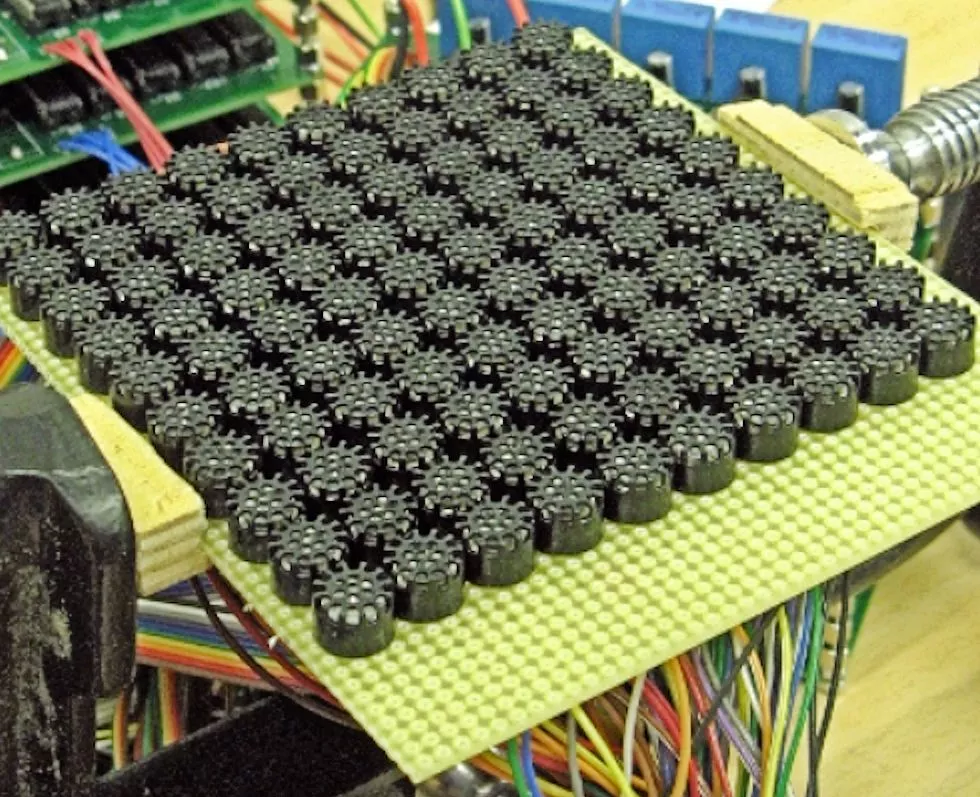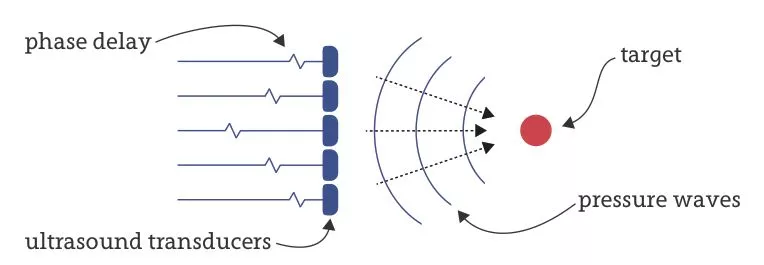Holodeck, anyone? Researchers at Bristol University are developing a system known as UltraHaptics that uses ultrasonic force fields to project the tactile sensations of objects in midair. Currently used for a haptic computer interface, the system might eventually enable touchable holograms.
The UltraHaptics projected tactile computer interface is a product of R&D carried out by the Bristol Interaction and Graphics (BIG) research group. It projects the sensation of touch by generating an intense focused point of ultrasonic radiation in the air over a computer display. This is accomplished by using a phased array of ultrasonic emitters to produce steerable focal points of ultrasonic energy that provide sufficient radiation pressure to be felt by the skin.
The value of tactile feedback from a computer interface is considered of such importance that a number of exploratory approaches toward accomplishing this goal have been attempted over the decades. These include using vibrating actuators attached to a user's body, reverse electrovibration to give a surface a desired feeling of texture (even at rates able to keep up with a video presentation), and projecting tiny vortices of air to produce tactile sensations away from a surface.
Unless one is standing near a large gun or a high-powered woofer, the notion that sound waves carry a pressure usually goes unnoticed. The sound pressure associated with the quietest audible sound is less than a billionth of atmospheric pressure. This pressure increases a factor of ten for every 20 dB increase in the intensity of the sound.

To steer focal points of ultrasonic energy above a computer display, the UltraHaptics system is equipped with a phased array antenna. This antenna contains 320 ultrasonic emitters in a 20 x 16 array. (The photo above shows a 10 x 10 prototype array.) The emitters (muRata MA40S4S) chosen operate at 40 kHz, are one cm in diameter, and can produce a sound level of 120 dB at 30 cm (12 in). This corresponds to an acoustic pressure of 20 Pa (1 Pa = 1 N/square meter). Each emitter costs about US$3, making the cost of the phased array antenna less than $1000, ignoring the cost of the power and phase control electronics.

An ultrasonic phased array antenna works in essentially the same manner as does a phased array radar antenna. However, while the radar antenna is producing a steerable radar beam, the UltraHaptics system is producing a steerable focal point (or several) of ultrasonic energy whose height above the antenna can also be controlled by varying the phase of the ultrasonics being emitted in the phased array. The size of the focal point is about 0.8 cm (0.3 in).
When you focus many emitters on the same spot, the sound level and acoustic pressure both increase. BIG has measured the acoustic pressure at a focal point of their acoustic phased array to be about 250 pascals – about 30 percent of the pressure you feel when a penny is resting on your fingertip. Although not a large pressure, it is more than enough to feel, particularly when the pressure is modulated by increasing and decreasing the power driving the emitters. Although human skin is sensitive to modulation frequencies between about 0.4 and 500 Hz, BIG used intermediate frequencies in the 50-200 Hz range for most experiments.
A number of potential improvements can be expected in the future of the UltraHaptics system. In its current form, the location of the user's fingers are identified using a Leap motion controller. However, recalling the similarity between the UltraHaptics system and a radar system, this function can readily be taken over by the ultrasonic apparatus. If a (far weaker) ultrasonic focus point is scanned over the interaction volume of the UltraHaptics system, the antenna can trace the location of objects (including hands and fingers) in that volume by detecting the reflected sound waves.
Another possibility is inspired by the recently disclosed COTA microwave-based wireless charging system. The COTA uses a modified radar capability to determine safe paths on which to project its power-carrying microwaves in a room which might be occupied while COTA is operating.
A similar approach could be used with the UltraHaptics system to produce tactile sensations at the location of, say, a holographic image, while sending the ultrasonic energy along safe paths, actively avoiding sending the high power ultrasonic waves into, for example, the hand of a user that is reaching toward an object in the image. The result would be a touchable hologram, something of great interest to display artists, the motion picture industry, and, inevitably, the porn industry.
The video below provides a good high-level description of the operation and application of the UltraHaptics system.
Source: Bristol University and BIG Ultrahaptics








